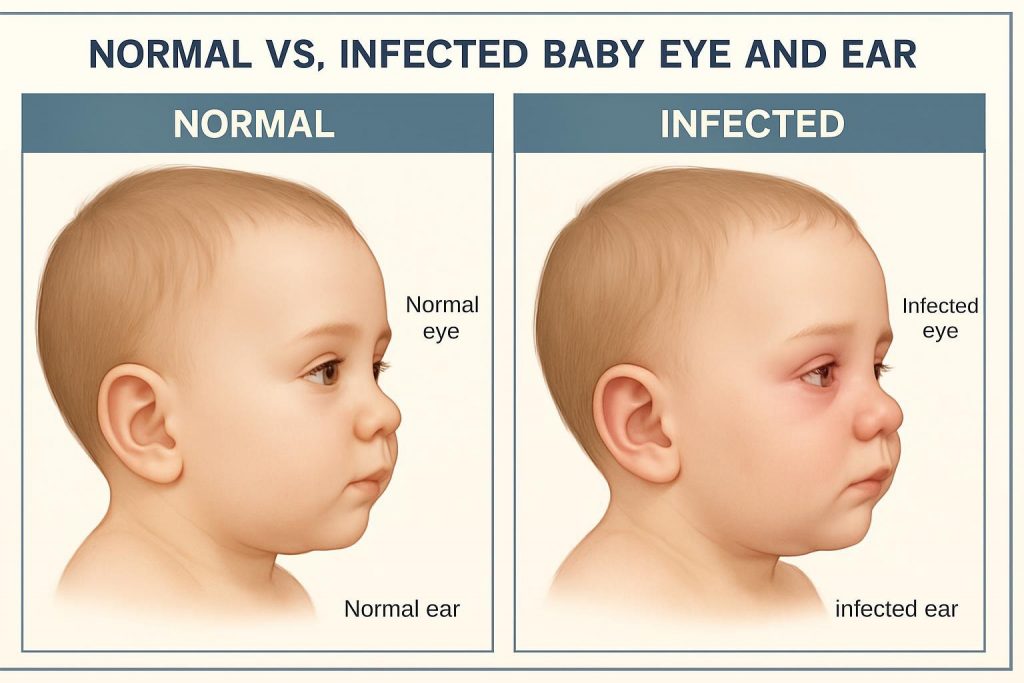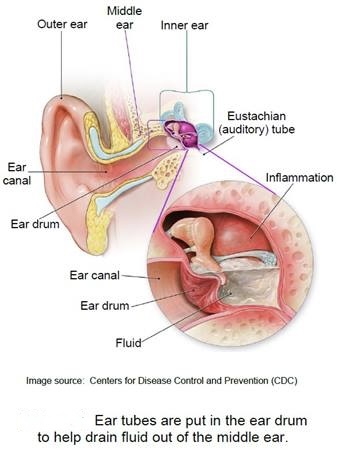Critical Statistics About Emergency Eye and Ear Infections in Babies
- 1 in 4 babies experience ear infections before age 2
- Emergency eye infections affect 0.3% of newborns annually
- 85% of cases are preventable with early recognition
- Delayed treatment increases complications risk by 300%
Emergency Eye and Ear Infections in Babies are among the most dangerous yet overlooked conditions parents may face. These 5 emergency eye and ear infections in babies can progress within hours, leading to irreversible hearing loss in infants or permanent vision loss in babies if not recognized and treated quickly.
Read this book: How to Care for Children:: From Birth to 2 Years – Selling by Amazon.com
⚠️ EMERGENCY WARNING
If your baby shows signs of any of these 5 emergency eye and ear infections, seek immediate medical attention. These conditions can cause permanent damage within hours.
Creating meaningful family traditions with your new baby.
Your baby’s developing sensory systems represent irreplaceable windows to the world, yet they remain heartbreakingly vulnerable to infections that can steal sight or hearing forever within hours of onset. As a parent, distinguishing between common childhood eye discharge or ear discomfort and sight-threatening or hearing-destroying emergencies can feel overwhelming, especially when your infant cannot verbalize their pain or describe what they’re experiencing.
The devastating reality is that serious cases among the 5 emergency eye and ear infections in babies can progress from mild symptoms to permanent sensory damage with terrifying speed, often while parents dismiss early warning signs as normal childhood ailments. Unlike adults who can describe their symptoms and seek help independently, babies depend entirely on their caregivers to recognize when routine infections become medical emergencies requiring immediate intervention to save their vision or hearing.
Recognizing the signs of emergency eye and ear infections in babies can save your child’s sight and hearing. This critical guide will transform you from an anxious observer into a knowledgeable guardian capable of recognizing when your baby’s eye or ear symptoms signal true medical emergencies that demand Fimmediate professional attention to prevent lifelong disabilities.
Quick Reference: The 5 Emergency Eye and Ear Infections in Babies
| Infection | Onset Time | Severity | Action Needed |
|---|---|---|---|
| Orbital Cellulitis | 12-24 hours | Critical | Emergency room immediately |
| Endophthalmitis | 6-12 hours | Severe | Urgent specialist care |
| Mastoiditis | 48-72 hours | High | Hospital admission |
| Complicated Otitis Media | 24-48 hours | Moderate-High | Urgent pediatric care |
| Neonatal Conjunctivitis | Birth-7 days | Variable | Same-day evaluation |

Understanding the 5 Emergency Eye and Ear Infections in Babies
Parents must recognize that the 5 emergency eye and ear infections in babies require different treatment approaches.
Baby’s eyes and ears undergo rapid development during the first years of life, making them particularly susceptible to infections that could permanently damage these delicate structures. The immune systems protecting these sensory organs are still maturing, creating windows of vulnerability where bacterial, viral, or fungal infections can cause irreversible harm.
Infants are especially vulnerable to Emergency Eye and Ear Infections in Babies because their sensory systems are still developing.
The American Academy of Pediatrics emphasizes that infant eye and ear anatomy differs significantly from adult structures.
Unlike older children, babies have immature tear ducts and eustachian tubes, that don’t drain effectively making them more prone to infections that can escalate quickly into medical emergencies and thinner protective barriers that allow pathogens to penetrate more easily. These developmental factors mean that infections can spread rapidly and cause more severe complications than similar infections in older children or adults.
Hearing loss in infants: Additionally, babies’ small anatomical structures mean that even minor swelling or inflammation can cause significant functional impairment, blocking drainage pathways or compressing vital structures in ways that can quickly lead to serious complications.
More information: Ear Infections in Children: Information for Parents – Health Children.org
Symptoms Checklist: 5 Emergency Eye and Ear Infections in Babies
Immediate Emergency (Call 911):
- [ ] Sudden vision loss
- [ ] Eye bulging forward
- [ ] Severe swelling behind ear
- [ ] High fever with altered consciousness
- [ ] Signs of meningitis
Urgent Care (Within 2 Hours):
- [ ] Inability to move eye normally
- [ ] Severe eye pain with fever
- [ ] Persistent ear drainage
- [ ] Facial paralysis
- [ ] Rapid symptom progression
#1 Orbital Cellulitis: Vision-Threatening Emergency Eye Infection
Permanent Vision and Hearing Loss in Babies: Orbital cellulitis is one of the most dangerous forms of Emergency Eye and Ear Infections in Babies, capable of causing blindness within hours if left untreated. Parents often mistake early signs for simple conjunctivitis, which delays proper treatment.
Recognizing the Progression: Orbital cellulitis typically begins with symptoms that may resemble simple conjunctivitis or a stye, including redness, swelling, and discharge. However, the condition rapidly progresses to involve deeper tissues, causing severe swelling that can completely close the eye, restriction of eye movement, and protrusion of the eyeball.
Critical Warning Signs: Key indicators include swelling that extends beyond the eyelid to involve the entire eye area, inability to move the eye normally in all directions, double vision, decreased vision, fever, and severe pain with eye movement. The affected eye may appear to bulge forward, and the child may seem systemically ill with high fever and lethargy.
Complications and Urgency: Untreated orbital cellulitis can lead to permanent vision loss, brain abscess, meningitis, and death. The infection can spread along nerve pathways to reach the brain, creating life-threatening complications within hours. Immediate hospitalization with intravenous antibiotics and sometimes surgical drainage is essential.
Risk Factors: Children with recent sinus infections, dental infections, or upper respiratory infections face higher risks. The condition can also develop following minor injuries around the eye or from spread of more superficial skin infections.
Proper newborn hygiene practices
#2 Endophthalmitis: Critical Eye Infection Emergency in Babies
Permanente vision and Hearing Loss in Baby advice: Endophthalmitis involves infection inside the eyeball itself, affecting the vitreous humor and potentially destroying all vision in the affected eye if not treated within hours of onset. This condition represents a true ophthalmologic emergency requiring immediate specialist intervention.
Clinical Presentation: Symptoms include severe eye pain, significant vision loss, redness, swelling, and sometimes a white or yellow appearance in the pupil. Babies may show extreme irritability, refusing to open the affected eye, and may have fever and signs of systemic illness.
Causes in Infants: Endophthalmitis can result from penetrating eye injuries, spread of infection from other parts of the body through the bloodstream, or rarely as a complication of eye procedures. In newborns, it may develop from infections acquired during birth.
Treatment Urgency: Treatment requires immediate injection of antibiotics directly into the eye, often combined with surgical removal of infected material. Delays of even a few hours can result in complete and permanent vision loss in the affected eye.
Prevention Emergency Eye and Ear Infections in Babies: Any eye injury, sudden vision changes, or severe eye pain requires immediate medical evaluation. Parents should never dismiss sudden changes in an infant’s visual behavior or appearance of the eye.
#3 Mastoiditis: Hearing-Threatening Emergency Ear Infection
Mastoiditis represents a severe complication of ear infections and is classified among the most urgent Emergency Eye and Ear Infections in Babies because it can lead to hearing loss, facial paralysis, or even brain infections.
Progression from Otitis Media: Mastoiditis typically develops as a complication of acute otitis media when infection spreads from the middle ear to the mastoid air cells in the bone behind the ear. The condition is more common in children under 2 years old due to their immature immune systems and anatomical factors.
Recognizing Mastoiditis: Key signs include swelling, redness, and tenderness behind the ear, with the ear appearing to stick out from the head. Children may have fever, irritability, hearing loss, and discharge from the ear. The area behind the ear may feel warm and appear inflamed.
Serious Complications: Untreated mastoiditis can lead to hearing loss, facial nerve paralysis, brain abscess, meningitis, and potentially fatal complications. The infection can spread along bone and soft tissue planes to reach critical structures in the head and neck.
Emergency Treatment: Mastoiditis requires immediate hospitalization with intravenous antibiotics and often surgical drainage of the infected mastoid bone. Early treatment is crucial for preventing permanent hearing loss and life-threatening complications.

#4 Acute Otitis Media: Complicated Emergency Ear Infection
While most ear infections in children are relatively benign, certain presentations of acute otitis media can quickly progress to serious hearing loss in infant complications that requiring emergency intervention.
Suppurative Complications: These include tympanic membrane perforation with persistent drainage, formation of abscesses in the ear canal or surrounding tissues, and spread of infection to adjacent structures. Children may show severe pain, high fever, and systemic signs of illness.
Intracranial Complications: Rare but serious complications include brain abscess, meningitis, and venous sinus thrombosis. Warning signs include severe headache, altered mental status, seizures, focal neurological deficits, and signs of increased intracranial pressure.
Facial Nerve Paralysis: Infection can compress or damage the facial nerve as it passes through the middle ear, causing facial weakness or paralysis. This complication requires immediate medical attention to prevent permanent nerve damage.
Treatment Considerations: Complicated ear infections often require hospitalization, intravenous antibiotics, and sometimes surgical intervention to drain infected material and relieve pressure on vital structures.
Learn more: The Diagnosis and Management of Acute Otitis Media – AAP (American Academy of Pediatrics)
Preseptal vs. Orbital Cellulitis: Critical Differentiation.
Distinguishing between preseptal cellulitis (infection of tissues in front of the orbital septum) and orbital cellulitis (infection behind the septum) is crucial because treatments and outcomes differ dramatically.
Preseptal Cellulitis: This involves infection of the eyelid and surrounding skin but doesn’t affect deeper orbital structures. While concerning, it typically responds well to oral antibiotics and doesn’t threaten vision or life.
Orbital Cellulitis Indicators: Signs that suggest orbital rather than preseptal involvement include restriction of eye movement, pain with eye movement, double vision, decreased vision, and proptosis (eye bulging forward). These findings indicate deeper infection requiring immediate emergency care.
Imaging Requirements: CT scanning is often necessary to distinguish between these conditions and assess the extent of infection. This imaging helps guide treatment decisions and identify complications like abscess formation.
Treatment Differences: Preseptal cellulitis may be treated with oral antibiotics on an outpatient basis, while orbital cellulitis requires immediate hospitalization with intravenous antibiotics and close monitoring for complications.
#5 Neonatal Conjunctivitis: Newborn Emergency Eye Infection
Conjunctivitis in newborns can be caused by various pathogens acquired during birth, some of which can cause permanent vision loss if not treated immediately.
Gonococcal Conjunctivitis: This bacterial infection can cause rapid corneal perforation and permanent vision loss within 24-48 hours if not treated with immediate systemic antibiotics. The condition presents with severe purulent discharge and significant eyelid swelling.
Chlamydial Conjunctivitis: While typically less acute than gonococcal infection, chlamydial conjunctivitis can cause chronic inflammation and scarring if not properly treated. It may also be associated with pneumonia in newborns.
Chemical Conjunctivitis: Caused by prophylactic eye drops given at birth, this condition is typically mild and self-limiting but must be distinguished from infectious causes.
Treatment Protocols: Newborn conjunctivitis requires immediate evaluation and often systemic antibiotic treatment, especially when bacterial causes are suspected. Topical antibiotics alone are insufficient for serious bacterial infections.
Chronic Otitis Media with Effusion: The Silent Hearing Threat
While not typically an emergency condition, chronic fluid accumulation in the middle ear can cause significant hearing loss during critical periods of speech and language development.
Hearing Loss Impact: Persistent fluid in the middle ear causes conductive hearing loss that can interfere with normal speech and language development, particularly if it occurs during the first years of life when language skills are rapidly developing.
Recognition Challenges: Unlike acute ear infections, chronic effusion often causes minimal pain, making it difficult for parents to recognize. Children may show delayed speech development, behavioral problems, or academic difficulties.
Treatment Considerations: Chronic effusion may require surgical intervention with tympanostomy tube placement to restore normal hearing and prevent developmental delays.
Monitoring Requirements: Children with chronic ear problems require regular hearing assessments and developmental monitoring to ensure normal progress in speech and language skills.
When to Seek Immediate Medical Care for Infant Eye or Ear Problems
Immediate Emergency Signs: Call 911 (in USA) or go to the emergency room immediately for sudden vision loss, severe eye pain with vision changes, signs of orbital cellulitis, suspected endophthalmitis, or any signs of intracranial complications from ear infections.
Urgent Medical Attention: Seek prompt medical care for persistent ear drainage, signs of mastoiditis, facial paralysis, severe headache with ear infection, or any rapid worsening of eye or ear symptoms.
Same-Day Evaluation: Contact your pediatrician immediately for newborn conjunctivitis, eye injuries, sudden hearing loss, or any concerning changes in your child’s vision or hearing.
How to Prevent These 5 Emergency Eye and Ear Infections in Babies
Infection Prevention: Maintain good hygiene, avoid touching eyes with unwashed hands, and seek prompt treatment for upper respiratory infections that could spread to eyes or ears.
Vaccination Benefits: Stay current with recommended vaccinations, including pneumococcal and Haemophilus influenzae vaccines, which can prevent many serious ear and eye infections.
Environmental Factors: Avoid exposure to cigarette smoke, which increases the risk of ear infections, and protect children from eye injuries during play and activities.
Regular Monitoring: Establish regular pediatric care relationships and don’t hesitate to seek evaluation for concerning eye or ear symptoms.
Understanding these 5 emergency eye and ear infections in babies can mean the difference between swift recovery and permanent complications.

CONCLUSION:
Your vigilance as a parent can make the difference between recovery and permanent disability. By understanding the risks, recognizing the signs, and acting fast, you can protect your child from the devastating effects of the 5 Emergency Eye and Ear Infections in Babies covered in this guide.
Preparing for parenthood challenges

Emergency Eye and Ear Infections in Babies
1. How can I tell if my baby has an eye infection?
Look for symptoms such as red or swollen eyes, yellow or green discharge, frequent rubbing, or excessive tearing. If you notice these signs, consult a pediatrician promptly.
2. What are the warning signs of an ear infection in babies?
Common signs include frequent ear tugging, crying during feeding or lying down, trouble sleeping, fever, and fluid draining from the ear.
3. Are eye and ear infections in babies dangerous?
Yes, if left untreated they can lead to serious complications such as vision or hearing problems. Early medical attention ensures safe and effective treatment
4. Can I treat my baby’s infection at home?
No. Home remedies are not recommended. Only a pediatrician can provide the correct diagnosis and treatment plan, which may include antibiotics or ear drops.
5. How can I prevent eye and ear infections in my baby?
Good hygiene is essential. Wash your hands before touching your baby, keep feeding bottles and pacifiers clean, avoid exposure to cigarette smoke, and ensure your baby receives all recommended vaccinations.

